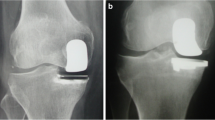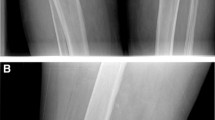Abstract
Background
This is the first study that reports on the mid-term results of 81 patients suffering from arthritis of the knee, treated with a cementless second-generation hydroxyapatite calcium phosphate (CaP)-coated tibial component.
Materials and methods
Seventy-six knees with osteoarthritis were evaluated according to the Knee Society clinical, functional and radiological score, the Hospital for Special Surgery Rating System and the Patella Score. The clinical and radiological parameters were assessed preoperatively and after a mean follow-up of 8.7 years.
Results
All the three score systems revealed excellent clinical outcomes after the follow-up period. The mean preoperative Knee Society clinical Score was 124.41 ± 12.99 and the mean postoperative score was 187.07 ± 14.59 at the time of the final consultation (p = 0.0008). The survival rate was 97.5 %. Radiolucency of <1 mm around the uncemented hydroxyapatite CaP-coated tibial component without accompanying pain symptoms was seen in fewer than 6 % of cases. In two cases, a medial cyst, also without other clinical symptoms, was observed beside the tip of the tibial fixation screw.
Conclusion
These findings indicate that the uncemented second-generation hydroxyapatite CaP-coated tibial component performed well at mid-term follow-up, and provides sufficiently stable bone ingrowth fixation.



Similar content being viewed by others
References
Berger RA, Rosenberg AG, Barden RM et al (2001) Long-term follow-up of the Miller–Galante total knee replacement. Clin Orthop Relat Res 388:58–67
Font-Rodriguez DE, Scuderi GR, Insall JN (1997) Survivorship of cemented total knee arthroplasty. Clin Orthop Relat Res 345:79–86
Duffy GP, Berry DJ, Rand JA (1998) Cement versus cementless fixation in total knee arthroplasty. Clin Orthop Relat Res 356:66–72
Moran CG, Pinder IM, Lees TA et al (1991) Survivorship analysis of the uncemented porous-coated anatomic knee replacement. J Bone Joint Surg Am 73:848–857
Rosenberg N, Henderson I (2001) Medium-term outcome of the LCS cementless posterior cruciate-retaining total knee replacements. Follow-up and survivorship study of 35 operated knees. Knee 8:123–128
Szmukler-Moncler S, Perrin D, Ahossi V et al (2001) Evaluation of BONIT, a fully resorbable CaP coating obtained by electrochemical deposition, after 6 Weeks of Healing: a pilot study in the Pig Maxilla. Key Eng Mater Bioceramics 13:395–398
DOT Dünnschicht und Oberflächen (2000) Bonit®- die Zweite Generation bioaktiver Calzium Phosphat Beschichtungen auf Implantaten, Rostock, Germany, product description 2000/07/09
Insall JN, Dorr LD, Scott RD, Scott WN (1989) Rationale of the Knee Society clinical rating system. Clin Orthop Relat Res 248:13–14
Ranawat CS, Shine JJ (1973) Duo-condylar total knee arthroplasty. Clin Orthop Relat Res 94:185–195
Turba JE, Walsh WM, McLeod WD (1979) Long-term results of extensor mechanism reconstruction. A standard for evaluation. Am J Sports Med 7:91–94
Ewald FC (1989) The Knee Society total knee arthroplasty roentgenographic evaluation and scoring system. Clin Orthop Relat Res 248:9–12
Park E, Cho M, Ki C (2009) Correct use of repeated measures analysis of variance. Korean J Lab Med 29:1–9
Lüring C, Kauper M, Bathis H et al (2011) A five to seven year follow-up comparing computer-assisted vs. freehand TKR with regard to clinical parameters. Int Orthop 2011:15
Helse-Bergen HF (2008) Annual Report 2008. The Norwegian Arthroplasty Register. Haukeland University Hospital. Retrieved from http://www.haukeland.no/nrl/.Haukeland
Ratanen P, Keinonen A, Mäkelä A (2004) The 2004 Implant yearbook of orthopaedic endoprostheses. Finnish Arthroplasty Register. Helsinki, Finland: Tikkurilan Paino Oy
Australian Orthopaedic Association (2009) National Joint Replacement Registry. Annual Report 2009 www.dmac.adelaide.edu.au/
Buechel FF Sr, Buechel FF Jr, Pappas MJ et al (2002) Twenty-year evaluation of the New Jersey LCS Rotating Platform Knee Replacement. J Knee Surg 15:84–89
Hardeman F, Vandenneucker H, Van Lauwe J et al (2006) Cementless total knee arthroplasty with Profix: a 8- to 10-year follow-up study. Knee 13:419–421
Hofmann AA, Evanich JD, Ferguson RP et al (2001) Ten- to 14-year clinical follow up of the cementless natural knee system. Clin Orthop Relat Res 388:85–94
Schroder HM, Berthelsen A, Hassani G et al (2001) Cementless porous-coated total knee arthroplasty: 10-year results in a consecutive series. J Arthroplasty 16:559–567
Watanabe H, Akizuki S, Takizawa T (2004) Survival analysis of a cementless, cruciate-retaining total knee arthroplasty. Clinical and radiographic assessment 10 to 13 years after surgery. J Bone Joint Surg Br 86:824–829
Cooke C, Walter WK, Zicat B (2006) Tibial fixation without screws in cementless total knee arthroplasty. J Arthroplasty 21:237–241
Cossetto DJ, Gouda AD (2011) Uncemented tibial fixation total knee arthroplasty. J Arthroplasty 26:41–44
Lewis PL, Rorabeck CH, Bourne RB (1995) Screw osteolysis after cementless total knee replacement. Clin Orthop Relat Res 321:173–177
Peters PC Jr, Engh GA, Dwyer KA et al (1992) Osteolysis after total knee arthroplasty without cement. J Bone Joint Surg Am 74:864–876
Gejo R, Akizuki S, Takizawa T (2002) Fixation of the NexGen HA-TCP-coated cementless, screwless total knee arthroplasty: comparison with conventional cementless total knee arthroplasty of the same type. J Arthroplasty 17:449–456
Nilsson KG, Karrholm J, Ekelund L et al (1991) Evaluation of micromotion in cemented vs uncemented knee arthroplasty in osteoarthrosis and rheumatoid arthritis. Randomized study using roentgen stereophotogrammetric analysis. J Arthroplasty 6:265–278
Kangasniemi IM, Verheyen CC, van der Velde EA et al (1994) In vivo tensile testing of fluorapatite and hydroxylapatite plasma-sprayed coatings. J Biomed Mater Res 28:563–572
Caulier H, Vercaigne S, Naert I et al (1997) The effect of CaP plasma-sprayed coatings on the initial bone healing of oral implants: an experimental study in the goat. J Biomed Mater Res 34:121–128
Reigstad O, Johansson C, Stenport V et al (2011) Different patterns of bone fixation with hydroxyapatite and resorbable CaP coatings in the rabbit tibia at 6, 12, and 52 weeks. J Biomed Mater Res B Appl Biomater 99:14–20
Reigstad O, Franke-Stenport V, Johansson CB et al (2007) Improved bone ingrowth and fixation with a thin calcium phosphate coating intended for complete resorption. J Biomed Mater Res B Appl Biomater 83:9–15
ten Broeke RH, Alves A, Baumann A et al (2011) Bone reaction to a biomimetic third-generation hydroxyapatite coating and new surface treatment for the Symax hip stem. J Bone Joint Surg Br 93:760–768
Bastian L, Hufner T, Mossinger E et al (2003) Integration of modern technologies in therapy of sarcomas of the pelvis. Computer-assisted hemipelvectomy and implantation of a “custom-made” Bonit gentamycin coated partial pelvic prosthesis. Unfallchirurg 106:956–962
Acknowledgments
The authors thank Mrs. Kaye Schreyer for editorial assistance and proof reading.
Conflict of interest
The authors declare that they have no conflict of interest.
Author information
Authors and Affiliations
Corresponding author
Rights and permissions
About this article
Cite this article
Wedemeyer, C., Kauther, M.D., Bülbül, M. et al. Cementless second-generation hydroxyapatite CaP-coated tibial component: an 8.7-year follow-up. Arch Orthop Trauma Surg 132, 1759–1764 (2012). https://doi.org/10.1007/s00402-012-1608-2
Received:
Published:
Issue Date:
DOI: https://doi.org/10.1007/s00402-012-1608-2




